196x Cross Country

Back Row: Clive Hardy, Charlie Holden, ‘Freddie’ Yarranton, B04, Brian Luckett
Front Row: Edwards, Peter Ford, Ian Sutherland, Pat Oven, Chadfield
 |
|

Back Row: Clive Hardy, Charlie Holden, ‘Freddie’ Yarranton, B04, Brian Luckett
Front Row: Edwards, Peter Ford, Ian Sutherland, Pat Oven, Chadfield

Please let me know if you can fill in any blanks or have any information.
A Class |
B Class |
C Class |
| Andrew, Duncan | Aerstall, Mick | Alexander, John |
| Bentley, Ian | Borrington, Chris | Ballinger, Paul |
| Brewer, Paul | Broughton, Paul | Brittain, Paul |
| Bond, Mick | Butcher, Philip | Broomfield, Kevin |
| Botham, Alan | Casement, Jamie | Calder Kurt |
| Carrington-Porter, Stephen | Chamberland, Geoff | Campion, Paul |
| Cartwright, John | Cooper, Edward | Curt, Nicolas |
| Chilton, John | Cooper, Simon | Dolling, Kevin |
| Clewes, Paul | Davies, John | Elson, Philip |
| Cockeram, Robert | Eaton, Alan | Farrell, Robert |
| Coleman, Graham | Eccleshall, Tim | Gilmartin, Michael |
| Cooper, Steve | Fern, David | Hall, Martin |
| Crump, Bernard | Fisher, Graham | Harrison, John |
| Clamp, Simon | Fisher, Nigel | Hartley, David |
| Earp, Peter | Foster, Stephen | Haywood, Edward |
| England, Chris | Gallagher, Kevin | Holmes, Peter |
| Hackett, David | Goodwin, Steven | James, Ivor |
| Hall, Martin | Holmes, David | Jarvis, Alan |
| Holmes, Stephen | Horton, Nicolas | Jones, Ian |
| Laxton, Steven | Hughes, Mick | Keable, Graham |
| Morgan, Alan | Jordan, Peter | Ladbrook, Tony |
| Murphy, Tim | Jones, Steve | McCombe, John |
| Presland, Jonathon | Keate, Paul | Mycock, Kenny |
| Stevens, Jeremy | Kurt, Roger | Nangle, Michael |
| Tindall, Alan | Moore, Paul | Parker, Mick |
| Taylor, David | Patrick, Russell | Peto, John |
| Taylor, Neil | Reavill, Andrew | Prosser, Shaun |
| Whetton, Robert | Richardson, Noel | Rose, Ian |
| Warner, Anthony | Shelton, Michael | Scott, Mark |
| Yates, Malcolm | Sherrat, Peter | Sherratt, David |
| Yates, Roger | Smith, Peter | Stubbs, Timothy |
| Teddar, Edward | Taylor, Steven | |
| Tomlinson, Mark | Tristram, David | |
| Trotman, Mark | Twigg, Christopher | |
| Westwell, Ian | Whifield, Ian | |
| Wild, Peter |


Back Row: B01, Steven Cort, Martin Briscoe, B04, Brian Luckett
Front Row: David Henton, F02, F03, F04

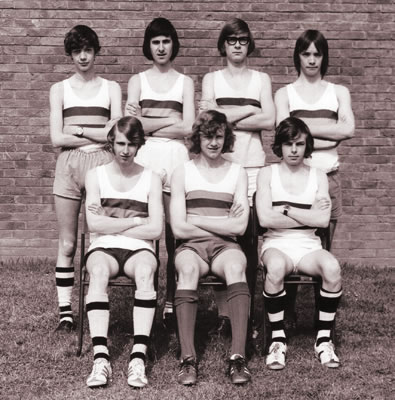
Back Row: Peter Earp, Philip Butcher, Steven Cort, Colin Ball
Front Row: F01, F02, Paul Ballinger

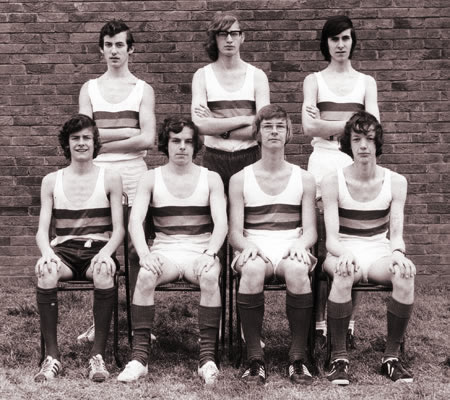
Back Row: David Hartshorn, Simon Larbey, Philip Butcher
Front Row: Mark Turner, Paul Ballinger, Steven Cort, Peter Earp

Bond Street school had become hopelessly inadequate after its 80 years of usage. It was in fact, already experiencing difficulties before the outbreak of the first world war.
In 1918, 1931 and 1938, plans for a new school had looked close to coming to fruition but had eventually fallen through. A new school might have succeeded earlier had it not been for the outbreak of the second world war shortly afterwards.
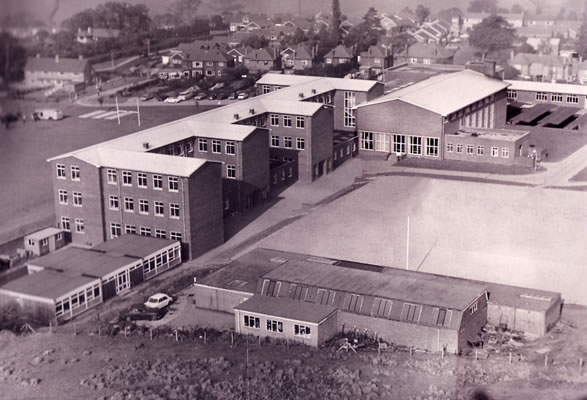
Finally, in 1952, plans for a new school were accepted. A deal was worked out to exchange the land currently belonging to the school for a new four acre site in Winshill. Final plans were completed on time for March 31st 1953. By 1955, building was very well on the way and it was expected that occupancy of the new school would begin after the school holidays in September, 1956. The school buildings would belong to the Governors, chaired by Mrs Evershed; all equipment would belong to the Town.
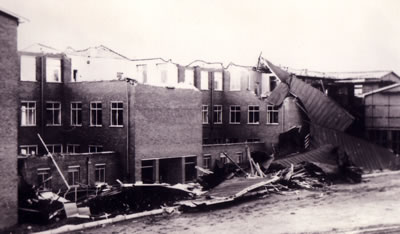 On February 29th 1956 however, disaster struck. The exposed site on the top of a hill had not been glazed, particularly the large staircases, and a freak storm with almost hurricane strength winds tore the entire roof off the school and destroyed supporting walls and sections of the building. This proved to be disastrous and was to put back the opening of the school for a full twelve months.
On February 29th 1956 however, disaster struck. The exposed site on the top of a hill had not been glazed, particularly the large staircases, and a freak storm with almost hurricane strength winds tore the entire roof off the school and destroyed supporting walls and sections of the building. This proved to be disastrous and was to put back the opening of the school for a full twelve months.
The final cost of the building, not including any furniture or equipment, was a little over budget at £192,744 4s. 4d. It was opened in 1957 by Lord Evershed.
Aside from the main school, a new ATC headquarters complete with rifle range was built, assisted by a grant from the War Department, remembering that this was not that long after the war, together with a scout hut. In 1962, a Sports Pavilion was added together with a playing field extension and running track in substitution for the old pavilion and playing field in Lichfield Street close to the old school.

The school was designed to accommodate 540 pupils. It was allocated a staff of 28 including a Headmaster and Deputy. The Headmaster at the time of opening was Herbert Pitchford, better known as Horace, who had been headmaster at Bond Street Grammar School since 1950 but was soon to retire to be replaced by William Gillion. The majority of the staff also transferred from Bond Street; it was slightly extended in the first year.
By 1966, despite the new, large Dovecliff Grammar School now also serving Burton, the school was struggling for space with now over 600 pupils. In 1967, a new three classroom block was built which included a Technical Drawing room, a Mathematics room and an expensively equipped Language Laboratory overseen by Hugh Wood.

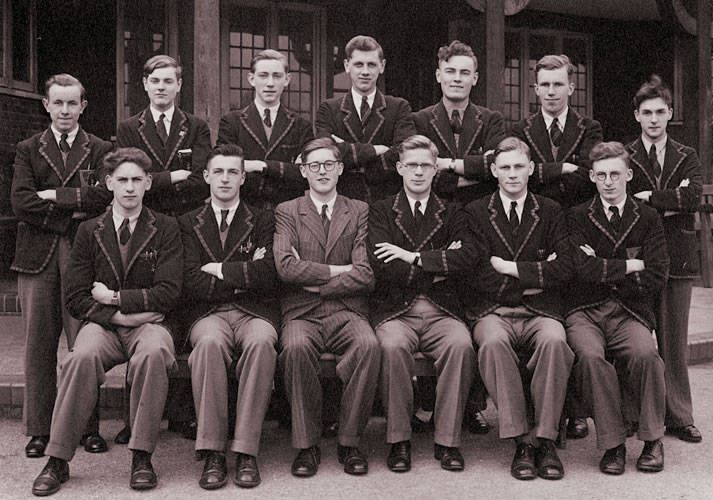 Dennis Grimsley belongs to one of the small number of staff whose association with Burton Grammar School started as a pupil before later returning to the teaching staff.
Dennis Grimsley belongs to one of the small number of staff whose association with Burton Grammar School started as a pupil before later returning to the teaching staff.
Dennis was a pupil from 1942 to 1950. He enjoyed good success, being a prefect in 1948/9 before going on to become Head Boy.
Aside from school colours for Rugby, Cricket and Cross Country, Dennis played for Derbyshire Schools Under 19′s Rugby XV in 1948/49 and was team captain 1949/50. He was also winner of the S.J.Ife Memorial cup in 1950 for ‘Best all round sportsman’. In the same year, he also became Captain of Drake Champion in a year when Drake were crowned House Champions.
Dennis gained a place at Nottingham University. He gained a 2nd Class Honours Degree in Chemistry in 1953 and a Certificate in Education 1954 when he was also appointed Chairman of the Education Department.
Soon after qualifying, Dennis served his National Service Commission from 1954 to 56 with the Royal Air Force. He married in 1956, just prior to demobilisation.
 His first teaching post was back at his own Burton Grammar School in 1956 as assistant chemistry master to Norman Jones. He was appointed President of the Old Boy’s Association for 1960/61.
His first teaching post was back at his own Burton Grammar School in 1956 as assistant chemistry master to Norman Jones. He was appointed President of the Old Boy’s Association for 1960/61.
In 1961, Dennis left Burton Grammar School to take up the post of Head of Chemistry at Brunts Grammar School, Mansfield, where he remained until 1970. Following this, he took the post of Deputy Headmaster at Biddulph Grammar School and was ‘Acting Headmaster’ during 1974 until, as part of a reorganisation, he was appointed Headmaster of Blythe Bridge High School. He remained here until 1988.
He was President of Biddulph Rotary Club 1978 – 79 and was appointed a magistrate in 1981 which he served until 2002.
 At various times, Dennis has been ‘Chairman of Probation Liaison Committee’; was ‘Chairman of Youth Panel of Leek’, then Staffordshire Moorlands and North Staffordshire. When this joined with Stoke-on-Trent, he became ‘Vice-Chairman of combined new North Staffordshire Youth Panel’.
At various times, Dennis has been ‘Chairman of Probation Liaison Committee’; was ‘Chairman of Youth Panel of Leek’, then Staffordshire Moorlands and North Staffordshire. When this joined with Stoke-on-Trent, he became ‘Vice-Chairman of combined new North Staffordshire Youth Panel’.
 Dennis was appointed a ‘General Commissioner of Income Tax’ in 1993 and became ‘Chairman of the Leek Tax Commissioners’ in 2003, a post he held until his retirement in 2007.
Dennis was appointed a ‘General Commissioner of Income Tax’ in 1993 and became ‘Chairman of the Leek Tax Commissioners’ in 2003, a post he held until his retirement in 2007.
…. to be continued …

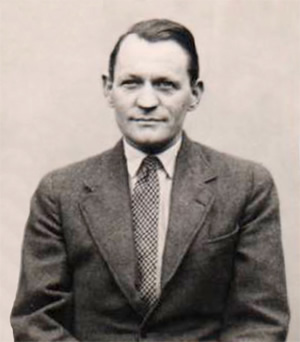 Ellick Thomas Ward was born in 1908 at Bingley, Yorkshire, the eldest of seven children and the only one of the siblings to enjoy a university education. He attended Bingley Grammar school, doing particularly well in French, History and Geography, although Physics, especially the construction of wireless sets, had been a main interest for him. In the Upper Sixth he was Senior Prefect and Rugby Captain and was quoted as “one of the most determined Rugby Forwards that the school has had”.
Ellick Thomas Ward was born in 1908 at Bingley, Yorkshire, the eldest of seven children and the only one of the siblings to enjoy a university education. He attended Bingley Grammar school, doing particularly well in French, History and Geography, although Physics, especially the construction of wireless sets, had been a main interest for him. In the Upper Sixth he was Senior Prefect and Rugby Captain and was quoted as “one of the most determined Rugby Forwards that the school has had”.
In 1928 Ellick was awarded the Roberts Memorial Leaving Scholarship, tenable at Leeds University. After graduating with a B.A. at Leeds in 1931 he continued studying for a Diploma in Education which he obtained in the following year.
His spoken French was good, and in 1930 he had visited France to work alongside French students in the flooded regions near Montauban.
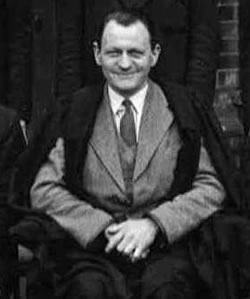 Ellick’s first teaching posts were at Bedford and then Doncaster, where he taught French, Geography, Mathematics, English and P.T. Always involved in extra activities, he was assistant scout master of one of the two scout troops at Doncaster, and Group scout master for Doncaster parish church. An unassuming, yet strong character, he is reported to have been much trusted and admired by the boys. At this stage he took the teacher’s certificate of the amateur Swimming Association and the Certificate for instructors in Air Raid Precautions.
Ellick’s first teaching posts were at Bedford and then Doncaster, where he taught French, Geography, Mathematics, English and P.T. Always involved in extra activities, he was assistant scout master of one of the two scout troops at Doncaster, and Group scout master for Doncaster parish church. An unassuming, yet strong character, he is reported to have been much trusted and admired by the boys. At this stage he took the teacher’s certificate of the amateur Swimming Association and the Certificate for instructors in Air Raid Precautions.
During the final years of the war, Ellick was headmaster of the village school at Natland, Westmorland, moving on from there to Burton Grammar School in 1944 to teach French.
At Burton he was able not only to pass on his love of the French language and French literature, but also to continue involvement with the School Scout Troop including taking boys to camp. He was also joint organiser during the war years of Harvest Camps. His swimming qualifications enabled him to give valuable assistance in the swimming instruction – in 1948 fifty boys each year were being taught to swim. His other enthusiasms were also communicated to others – he organised a successful stamp club, and later a radio society – the school had its own radio amateur call-sign. As careers master he took a special interest in building local links to employers in order to help the careers of boys who did not intend to apply for admission to universities.
 He was associated from its formation with the local branch of the Alliance francaise, and was concerned with French exchanges. For several years he, Norman Jones and others escorted parties of boys to Belgium where they stayed at the Hotel Venise du Nord in Bruges and enthusiastically explored the area.
He was associated from its formation with the local branch of the Alliance francaise, and was concerned with French exchanges. For several years he, Norman Jones and others escorted parties of boys to Belgium where they stayed at the Hotel Venise du Nord in Bruges and enthusiastically explored the area.
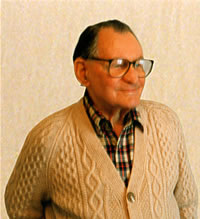 Ellick retired in 1973, glad that he was not involved in the change over to a comprehensive school (even the move from the town centre to Winshill he had scorned as a move to the ‘biscuit factory’).
Ellick retired in 1973, glad that he was not involved in the change over to a comprehensive school (even the move from the town centre to Winshill he had scorned as a move to the ‘biscuit factory’).
In retirement he enjoyed extensive travel, especially to Greece and to Egypt, lands which as a boy he had yearned to visit. As a radio amateur he continued to converse with contacts all over the world. A year after the death of his wife, Kitty, he married Peggy Bostock, a former teacher from Byrkley Street School and continued to live life with enthusiasm until his sudden death in 1998. Ellick is survived by his daughter, Christine, a former pupil of Burton Girls’ High School, and by his two grandchildren, Marion and Edmund.
…. to be continued …

By 1964, Burton Grammar School had reached what might be thought of as its heyday.
The new pavillion and extension to the sports fields, including a running track, had recently been put into service. Never before had the school achieved such accademic success. For the first time, over 100 pupils enjoyed ‘O’ level passes, several students were being awarded Open Scholarships at top universities and around 30 students a year were successfully gaining university placements, sometimes out-performing the nearby Repton Public School. The sun was shining!
This was two years before the very first mention of a re-organisation of secondary education. It would have been inconceivable at the time that the Grammar School System, with its centuries of tradition, was soon to be abolished.
On a slightly sad note, the year also saw the death of Miss Mitton who had been the Headmaster’s Secretary for twenty-two years, spanning several Headmasters having been originally appointed by Mr Moodey. She was almost considered ‘part of the furniture’.

Click here to view large image
In happy times, another complete school photo was commissioned as a celebration. A mischievous Paul Wheildon at the far right, timed his pose to perfection, escaping the eye of the photographer until after it had been printed.

A couple of supplied photos taken in 1959 are too good to leave out because they capture the mood so well.
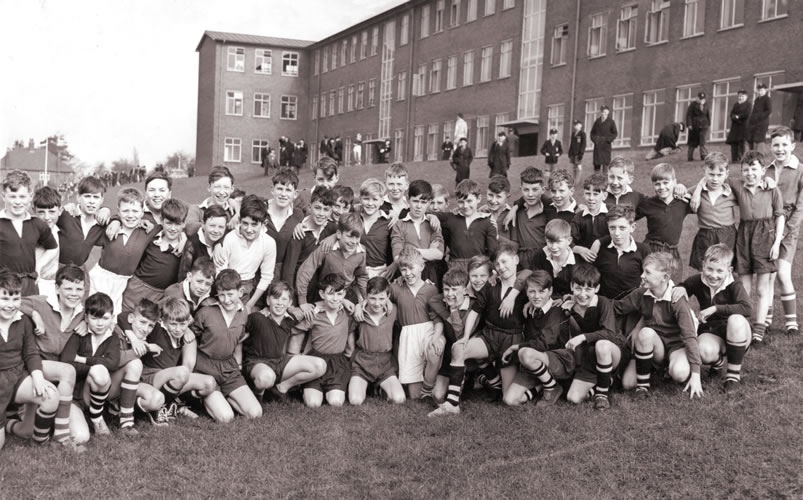
There are probably a few too many to name but they show the first-formers kitted up ready for ‘games’. The fact that the photo is black and white hides the assortment of Blue (Drake), Green (Clive), Maroon (Wellington) and Black (Nelson) shirts and socks.

